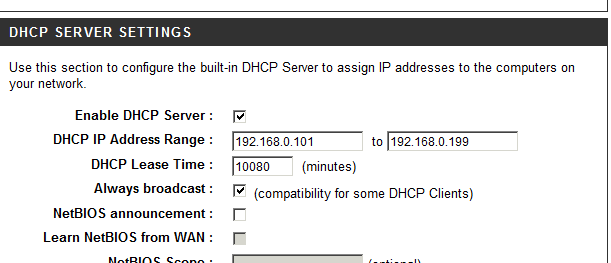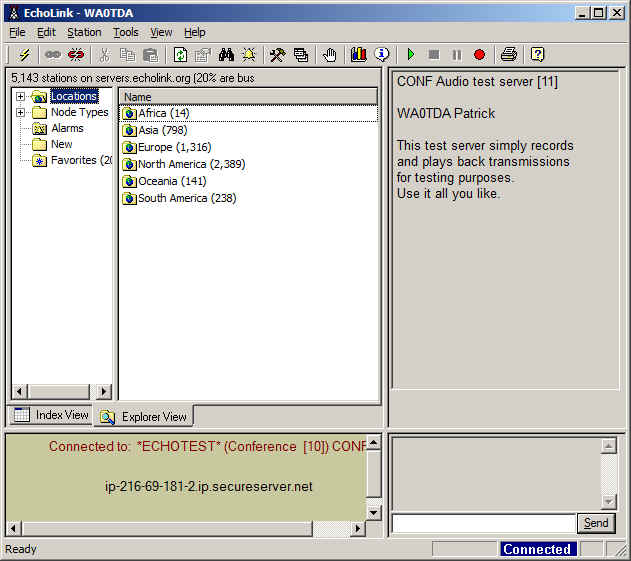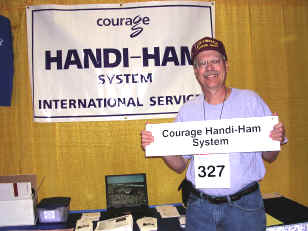Welcome to Handiham World!

Can ham radio help promote science education?
Last night many of us watched the proceedings from Washington, DC as Congress and the President gathered for the State of the Union address. I don't think any of us were surprised to hear some of the comments about how the United States needs to stay competitive in a new world where science, technology, engineering, and math are more important than ever. It seems to be something that everyone can agree on. These four subjects are sometimes referred to by their acronym, "STEM". There has been much talk lately about how to energize and motivate our young students to learn more science and math, which will ultimately lead to a better understanding of technology and perhaps more students of science and engineering later on down the road. For quite some time now the United States has been importing highly educated scientists. I live in a neighborhood that is close by a well-known Fortune 500 company that employs a lot of scientists. It is no surprise to me that some of them have come from other parts of the world.
"What", you may ask, "does this have to do with ham radio?"
Well, if you think about it, ham radio encompasses STEM – science, technology, engineering, and math – all in one fun and interesting activity. All of us know that ham radio has many different facets. You can have an interest in public service communications and earn your Technician license in order to participate in the types of communications exercises and responses that serve the public interest. Following 9/11, many people did just that because interest in public service was so strong. That fundamental reason for the existence of the Amateur Radio Service is still there and still attracts and holds many participants.
There are, however, lots of amateur radio operators who simply like to do other things. Some may be interested in just getting on the air to make contacts and make friends in the process. Others may get on the air because they are competitive and like to participate in contests and chase awards. One traditional interest area is in engineering, which will frequently involve designing and building one's own equipment. It is also necessary to recognize that writing software is another amateur radio activity that holds the interest of a small but important minority. All of us know that every level of the amateur radio licensing process involves learning some science and math. The Extra Class exam takes math understanding to a much higher level than what might be found in the typical population. I guess we could say that ham radio does sometimes serve as an entry point to learning about how science, technology, engineering, and math can be applied to an activity that is both fun and educational. Furthermore, the options for learning in amateur radio are virtually open-ended. I feel that I will never, ever stop learning new things in amateur radio. Because it is a technical activity by its very nature, it will always be evolving and there will always be a necessity to learn about new technologies and the science and engineering that make them possible. In ham radio, I can learn in a "hands-on" way that will reinforce the knowledge and make it more useful to me.
We saw a definite surge in the interest of the general public about amateur radio after the twin towers fell in New York City. Today we face another crisis where our students are falling behind in science and math. Perhaps amateur radio has a role to play in recruiting more people, young and not so young, to learn more about these vital subjects and in the process to make our country and our world a better place. And when you talk about making the world a better place, what could be a better way to start than by communicating via amateur radio worldwide?
One final thought: When I am asked about what I think is the most important thing that I can contribute in my local amateur radio club, my answer is always the same. Teaching. Every time our club holds classes, I volunteer to teach at least some of them. Amateur radio operators who teach in the public schools have even more opportunity than I do to position amateur radio as a fun learning activity. ARRL has long supported outreach to teachers and has many useful resources. If amateur radio can be used to help promote learning in the four STEM topics, it can be one more tool in the successful teacher's toolbox.
Patrick Tice, WA0TDA
Handiham System Manager
wa0tda@arrl.net
Proposal for a Skype study hall
We have an ongoing need for some kind of forum in which technical assistance or study assistance can be offered to our members. One idea that crossed my mind was to run a Skype conference with up to 10 participants. This would allow a number of people to discuss some topic of interest in a small group setting in a more private forum than one could find on EchoLink, for example. Does anyone out there have any ideas or experience with this kind of a project? I have taken several webinars where we are all connected in a small group audio session. Generally there is also a shared computer screen operated by the presenter of the webinar. I think a Skype audio forum for a small group would work pretty well. We are mainly interested in audio because we will pretty much always have blind participants and would not want to bother showing screens. In order to make this work, participants would have to sign up for a free Skype account and share their Skype contact information with the presenter.
One use for something like this might be to get questions about the remote base stations out there into a discussion group. Participants could discuss any issues they might have and benefit by learning what others have done to get something working. The same could be said about EchoLink or any other technical topic. The thing about a conference like this that is completely different than an e-mail exchange or even two people talking on the telephone is that the conversation is spontaneous and when you put more heads together you are more likely to get a variety of useful and creative responses.
We could probably start with a scheduled conference at a particular time each week and see how it goes. If anyone is interested in this idea and is willing to get in on the ground floor while we test it out, please let me know at wa0tda@arrl.net. Of course we will have to work out details like whether we should start a new Skype account specifically for this purpose and if so, what we should call it. One of the things that has always been true about ham radio is that "hams helping hams" advances our hobby and makes us all feel good. A Skype conference might just be another way to do that.
Tapes reach the end of the line - sort of

This question was put out this morning on the Handiham Radio Club list, but I want to let those of you who are not members of our radio club know what we are discussing. I want to get your opinion on tape cassettes. Over the years we have offered various manuals and other audio books on tape. I'm sure all of you know that the use of cassette tape has gone down each year, and now we are at the point of filling very few member requests for anything at all on cassette tape. We still do have a small but significant number of users who get the monthly magazine digests on tape. Most of our members are able to simply download the material from our website. In fact, prices have not changed for tapes in years. Nancy and I feel that it is time to discourage the use of tape manuals by increasing the price to reflect the fact that these are special order items that must be custom made one at a time. It is no longer the old days when we had bins of instruction manuals on tape and it was simply a matter of picking one out and mailing it. A typical cassette tape manual on a single tape is priced at five dollars, which is the minimum price for a tape order. However, some are three tapes long and sell for six dollars. This amounts to giving them away, considering all of the effort that needs to go into them. (It has never really been about the cost of the tape itself. The work and mailers add most of the cost.)
Can any of you tell me what a similar book would cost from another agency or provider? While we are happy to help folks find what they need in terms of resources, it doesn't seem fair to put a lot of effort into an old medium like cassette tapes just because a few people don't want to change to digital.
Thank you for your thoughts on this matter. We look forward to hearing from you. Unless you are replying via the radio club list, you should send me an email. Please don't just hit "reply" to this message. I get a lot of mail, and I will be watching for an email to wa0tda@arrl.net with Tapes in the subject line. When I get replies to newsletters that are sent via the distribution list, they will probably be last to be looked at, and then only to change subscription properties.






